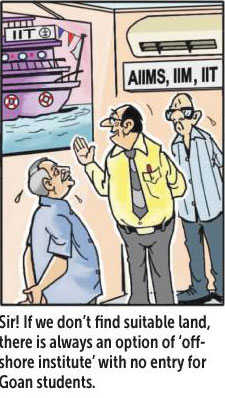11 Dec 2017 | 04:06am IST
Focus now on conservation of fish resources
Explaining reasons for the recently imposed ban on LED fishing across the country, Union Agriculture Minister Radha Mohan Singh said that the decision will benefit the traditional fishermen and bring an end to the mafia raj in the fishing industry. Traditional fishermen had been long opposing fishing that uses LED lights to attract shoals of fish claiming that it impacted them severely, leading to reduced catch.
Goa was one of the States that had been demanding a uniform ban on LED fishing across the country, and last year, the State’s decision to ban it had drawn both cheers from the traditional fishermen and criticism from the trawler owners. It was also Goa, who had already imposed such a ban on its fishing craft, that pressed upon the Union government to extend this ban across the entire coastline, so that there is uniformity on this in the country.
The issue is simple. Purse seine trawlers used LED lights at night to attract fish and net themselves a bigger catch. The ramponnkars and traditional fishermen who opposed this claimed that the LED lights were being used within the territorial waters of the State, that is within 12 nautical miles which is a violation of the Goa Marine Fishing Regulation Act. They argued that since no fishing boat in Goa is registered to operate beyond 12 nautical miles, the use of LED lights within this area is destructive to marine ecology.
They claimed that fishing with LED lights would lead to some depletion of marine resources and in turn cause a ‘fish famine’ in the State. They had also raised concerns of extinction of certain species of fish due to this, as the flashing LED lights would attract the mother fish and lead to decreased breeding and also juvenile fish from shallow waters destroying the breeding grounds and hence the resultant fish famine. There, however, was the counter argument that these fishing methods are not resulting in any damage to the environment or to breeding sources, and so does not adversely hit fishermen using canoes or small boats. They had also claimed that since ramponnkars and traditional fishermen are restricted to an area of five nautical miles from the shore, such fishing techniques would not affect them.
Whether LED fishing and bull trawling were leading to overexploitation will be revealed in the months ahead. Very loosely, a drastic drop in the fish catch, would indicate that the fears expressed by the traditional fishermen were real. If the tonnage of fish brought to shore remains constant, then questions of whether LED fishing and bull trawling were leading to over exploitation will arise. The overall fish production in the country stands at around 11.41 million tonnes annually, which is about 6.2 per cent of the global fish catch. India, in comparison, actually saw a much higher growth rate in the industry of 14.8 per cent, as against the global growth rate of 7.5 per cent in the last decade.
Given this background, it becomes pertinent to scientifically study the issue of LED fishing thoroughly, especially the fear that there was destruction of several fish species, and also their habitats and nursing grounds. If there has been any such damage, then efforts will need to be made to repair the damage. Conservation of fish species for future generations has to be the focus of the fishing industry, not just in India, but globally.
With the uniform ban on LED fishing and bull trawling, there is a level playing field across the country and Goan fishermen cannot complain that the fishermen from the neighbouring States have an edge over them. There is no advantage for anybody now.
